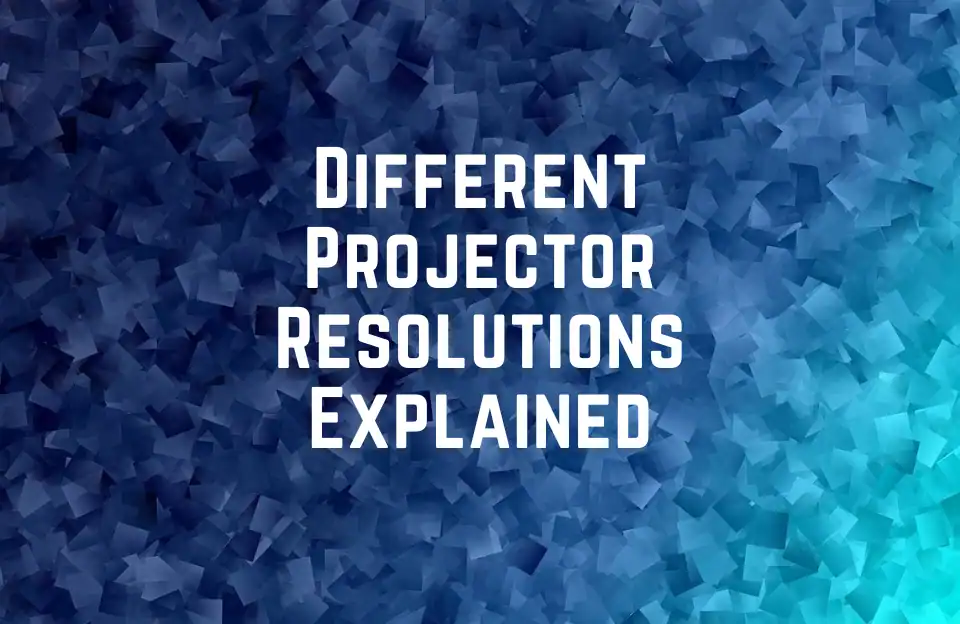When you’re shopping for a projector, it can be difficult to know what resolution is right for you. After all, there are so many different options out there! You’ve got HD, 1080p, 4K, 3D, and even 8K projectors—and that’s just the beginning. There are so many different types of projectors out there that come with different resolutions so choosing the right one can be tricky.
When it comes to projector resolutions, you’ve got a few options. You can go with a projector that has a fixed or native resolution, or you can opt for a projector that has a variable resolution.
But what exactly are these different types of resolution? Why are they essential to understand? And how do you choose which one is right for you? This detailed Guide will explain the different projector resolutions in detail and list the common resolutions with each resolution means.
What is a Resolution?
A resolution is defined as a measurement of how many pixels the image can be displayed on the screen. A resolution is the size of a pixel, which is the smallest unit of measurement that digital devices use. The more pixels in a screen, the larger the resolution. There are different types of resolutions available depending on the kind of devices you use to view images.
A resolution is a way of describing the pixel dimensions (i.e., width x height) of a screen. For example, 1024 × 768 means the width is 1024 pixels and the height is 768 pixels.
How to Measure Resolutions?
Resolutions are measured in “pixels”, which are the smallest unit that can be displayed. A pixel is a dot in the image that represents the light source of a single dot of an image. The pixels are grouped together to form the picture or text on the screen. The greater the resolution of the display device, the higher quality of the image can be.
For example, a display has about 1024 pixels wide. The quality of the screen is very high because many devices are using these screens to view content.
What is Pixel Density?
A resolution is a combination of screen size and pixel density. A resolution is also expressed in units of pixels per inch.
Pixel Density (PPI)
The term resolution is used in two different ways: first, it refers to the pixel density of the display, and second, it refers to the number of pixels available on the screen.
A screen with a higher pixel density (not the total number of pixels) has more pixels per square inch than a screen with a lower pixel density. A digital device’s display resolution is measured in pixels per inch (PPI).
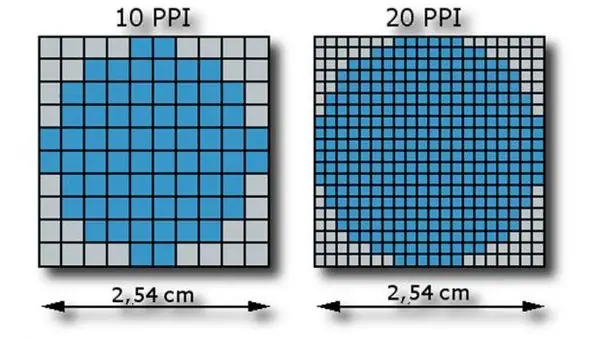
The size of a pixel is actually the smallest physical element in the image, which represents a single dot on the screen. Pixels are the basic units used to define the size of an image on a screen. The pixel density of a display is usually given as pixels per inch (PPI). A display with a greater density of pixels (PPI) will appear crisper and clearer.
What does Projector Resolution mean?
A projector is an electronic device that takes an image or picture and projects it on a screen. Projectors come in all sizes and shapes. Some are very portable and can be taken along wherever you go. A projector resolution is the number of pixels on the screen in the X-Y direction.
The number of pixels in the horizontal (X) and vertical (Y) directions determines the resolution. If a projector has a resolution of 1920 by 1080 pixels, then the resolution of the image is 1920×1080.
If you have a big screen with a low-resolution projector, then you will be able to enjoy a very large screen with a clear and sharp picture. But if you watch movies on a small screen and the projector has low resolution, the picture will look very poor.
A high-resolution projector can show you a much bigger picture on a smaller screen. So, the resolution of the projector plays a vital role in showing a clear and crisp picture.
Projector Resolution vs Native Resolution
A projector is a device that projects images onto a surface such as a wall or a screen. The resolution of the projector determines the quality of the picture.
A projector screen is a big flat panel that has millions of tiny projected squares in a regular pattern. The size of the square that is used to make up the image determines the resolution. Projector Resolution refers to the amount of pixels in the image being displayed. A native resolution is the number of pixels on the actual video projector chip itself.
Native Resolution
A projector has a number of pixels on its chip. This means that the maximum resolution that a projector can show is given by this value. When you put a picture on a screen, your computer sends a signal to the projector telling it to show the resolution at which the picture is being displayed. This is measured in terms of dots or pixels. A higher number of pixels means that the projector can reproduce a more detailed image.
For example, A projector that uses LCD or DLP chip is capable of displaying high-definition content on a screen. If you are displaying a 1080p picture, then the projector will show the picture at 1920 pixels wide and 1080 pixels tall.
On the other hand, if you are showing a 720p picture, then the projector will show the picture at 1280 pixels wide and 720 pixels tall. A 1080p projector should be able to display all the resolutions up to 1080p.
If you want to make sure that you are getting the perfect picture, you should check the native resolution of the projector.
How Do the Projector Resolutions Affect Image Quality?
There are two ways to make sure that your movie or video looks good when it is projected on an HD projector. The first way is to make sure that you are using the right projector resolutions. It is a fact that the amount of pixels in a video or picture has a direct impact on its quality.
If you are using a projector with a high resolution, you will get crisp and clean pictures. It is easy to find a projector with a higher resolution than 1080p. The second method is to reduce the amount of brightness. If you are watching a movie in a dark room, you may want to reduce the brightness.

The Importance of the Projector Resolution
Today, all high-definition displays and projectors are equipped with resolutions that are at least 720p. This is because the higher the resolution, the sharper and more detailed your image will appear.
This is especially true when you are watching movies or playing video games. It is important to have the right resolution for the movie or game that you are playing. If you play a movie at a resolution that is too low, the picture will appear blurry.
If you play a game at a resolution that is too low, you will get fewer details. It is important to make sure that the projector is capable of producing a quality image at the resolution that you want. Projector resolutions are usually measured in pixel counts per inch (ppi).
The higher the number, the more pixels per horizontal line, and the sharper the image. This is why the higher the number, the better the image looks. It is recommended to stick to the highest number of your projector, which is at least 720p.
Projector Resolution & Projector Aspect Ratio
A projector’s resolution and aspect ratio are important. This is because they are directly tied together.
There is a lot of confusion about the resolution and aspect ratio. Resolution refers to the number of pixels that make up an image. This number is usually expressed in terms of dots per inch. It can vary from as low as 10 to as high as 1000 (pixels).
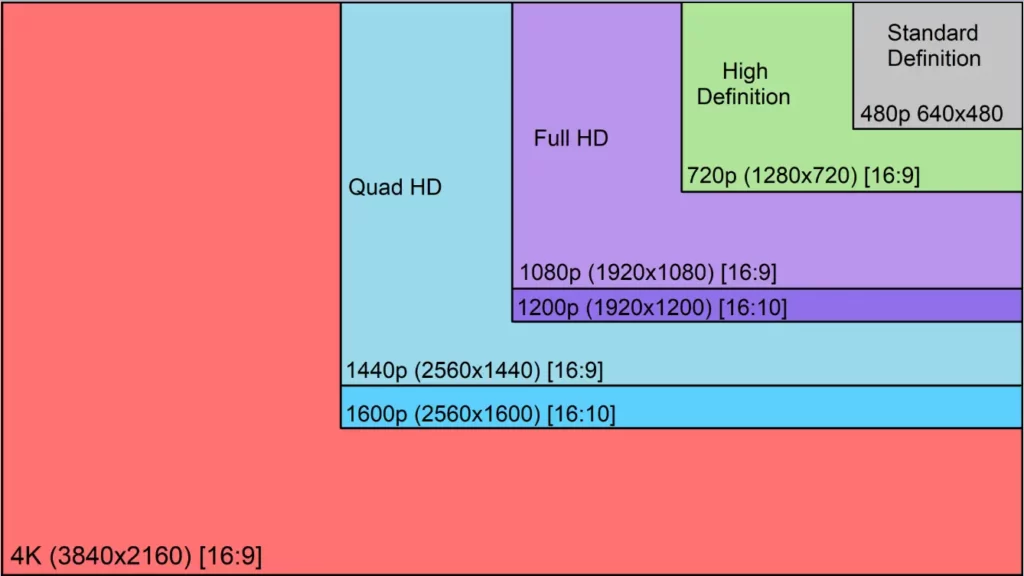
The aspect ratio refers to the ratio between the width and height of the image. It is measured as the width divided by the height (width/height). This number is usually expressed in terms of the ratio of width to height.
For example:
- 4:3 – A 4:3 aspect ratio Wide-screen has a ratio of 4 to 3, which means a width of four units and a height of three units. Commonly used for television sets (square) with 800 x 600 resolution.
- 16:9 – A 16:9 aspect ratio has a ratio of 16 to 9, which means a width of 16 units and a height of 9 units. Most video content from the Internet, DVDs, and Blu-rays is formatted for this ratio of 1280 x 720.
What are the different Resolutions?
The resolution of your projector is one of the most important factors that you should consider before purchasing a projector.
There are several different projector resolutions out there that you can choose from. For example, you have XGA, WXGA, HD, and 4K. These resolutions are offered by today’s projectors. The XGA is the lowest resolution that you can use. The next one is the WXGA. The 4K is the highest resolution that you can choose from. The 4K is used in movies, TV shows, and sports events.
Different Resolutions Overview
| Acronyms | Resolution | Pixel Density | Aspect Ratio |
| nHD | 640 x 360 | 230,400 | 16:9 |
| SVGA | 800 x 600 | 480,000 | 4:3 |
| XGA | 1024 x 768 | 786,432 | 4:3 |
| WXGA or HD or 720p | 1280 x 720 | 921,600 | 16:9 |
| WXGA | 1280 x 800 | 1,024,000 | 16:10 |
| SXGA | 1280 x 1024 | 1,310,720 | 5:4 |
| WXGA+ | 1440 x 900 | 1,296,000 | 16:10 |
| HD+ | 1600 x 900 | 1,440,000 | 16:9 |
| UXGA | 1600 x 1200 | 1,920,000 | 4:3 |
| FHD or 1080p | 1920 x 1080 | 2,073,600 | 16:9 |
| WUXGA | 1920 x 1200 | 2,304,000 | 16:10 |
| UWFHD | 2560 x 1080 | 2,764,800 | 21:9 |
| QHD or WQHD | 2560 x 1440 | 3,686,400 | 16:9 |
| UWQHD or 1440p | 3440 x 1440 | 4,953,600 | 21:9 |
| 4K UHD or 2160p | 3840 x 2160 | 8,294,400 | 16:9 |
| 8K UHD-2 | 7680 x 4320 | 33,177,600 | 16:9 |
The Most Common Resolutions Used for Various Applications
There are several resolutions to choose from. You should think carefully before choosing the resolution that you like the most. You should think about the size of your screen and its importance to you. The first thing you need to know about resolution is that a higher number means that the picture quality is better. The other thing you should keep in mind is that the resolution will determine the pixel count. The higher the pixel count, the higher the quality of the picture. You should decide on the number of pixels depending on the size (aspect ratio) of your screen.
There are different types of resolutions. Some of the most common are listed below.
High-Definition Display Resolution
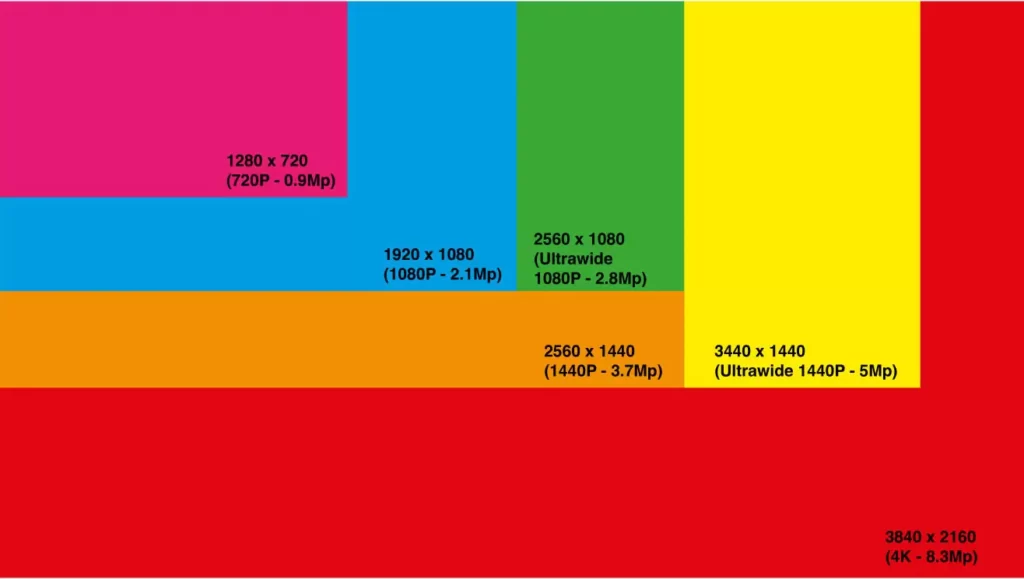
- 720p or 1280 x 720: This is also known as high definition (HD) resolution. It has a widescreen aspect ratio of 16:9. HD resolution is used in HD (standard) HDTVs.
- 1080p or 1920 x 1080: This is also known as FHD (Full HD). It is the highest standard of high-definition video resolution. 1080p is the most common High Definition resolution and standard resolution for broadcast applications. It is ideal for watching movies and TV shows at home using a projector.
- 1080p or 2560 x 1080: This is also known as WFHD (Wide-FHD) or UWFHD (Ultra-Wide FHD). It comes with an ultra-widescreen aspect ratio of 21:9. It can display the content in Ultrawide formats. It is a very good option to play your favorite game at an Ultra-Wide angle.
- 1440p or 2560 x 1440: This is also known as 2K or QHD (Quad HD). The number of horizontal pixels is 2560, that’s why it is also called 2K. It is four times the “HD” resolution. This resolution of WQHD (Wide Quad HD) comes with a 16:9 aspect ratio. You will get better-quality pictures on your screen as it provides good color accuracy.
- 2160p or 3840 x 2160: This resolution is also known as 4K or UHD (Ultra HD). A 4K resolution is capable of displaying images at a resolution of about 4,000 by 2,000 pixels. These displays are typically used for watching 4K movies or playing games. The true 4K resolution is 4096 x 2160.
- 4320p or 7680 x 4320 – This is also known as 8K or UHD. There is no home theater screen yet to display such kind of resolution at home. This is a more advanced technology and is not yet ready to display in home entertainment.
Graphics Display Resolution
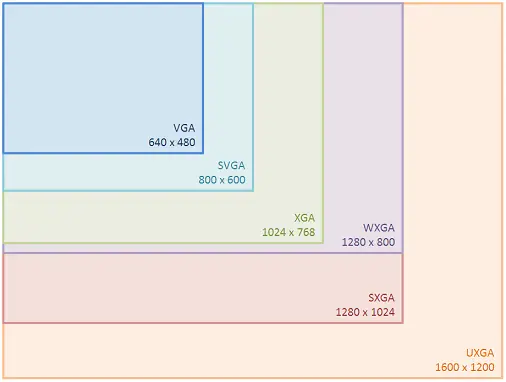
- SVGA: The resolution of SVGA is 800 x 600. This resolution is the same as the resolution of the computer monitors from the 1990s. The SVGA was originally designed for business purposes. Businesses needed a projector that could display high-quality graphics.
- XGA and SXGA: Projectors with resolutions like 1024 x 768 and 1280 x 1024 pixels are considered to be standard. These are the most popular projector resolutions for notebooks and laptops. Many of them support both HD and 3D projection.
- WXGA or HD or 720p: This resolution comes with 1280 x 720 pixels. This means that you can display 1280 lines of text on the screen and 720 pixels on each side of the screen. You can use this type of projector for showing charts and graphs offering higher detailed content.
- UXGA and WUXGA: They will provide you with an excellent experience and allow you to focus on the content of your presentation. These business projectors can be used by most business professionals. They will display images, animations, videos, PDF documents, and many other formats.
What are Resolutions used in Cinema?

In digital cinema, the resolution is determined by the number of horizontal pixels. A resolution of 2048×1080 pixels is called a 2K resolution. A resolution of 4096×2160 pixels is called a 4K resolution. The 2K and 4K resolutions used in digital cinema projection are often referred to as DCI 2K and DCI 4K. The DCI stands for Digital Cinema Initiatives, which is a committee of the Motion Picture Association of America.
Choosing the Best Projector Resolutions
You might have a budget in mind, or you might need something that has the most features and is easy to use. Either way, you’ll want to make sure you’re getting the best value for your money. Here are some things to consider when you’re shopping for a projector.
Then, you can choose the highest resolution that your projector supports. If you have a newer projector, it will support 4K. You can watch movies in 4K resolution. There is a growing demand for 4K resolutions because people can watch the latest movies in 4K. If you want to watch 4K movies, you will need a TV with 4K resolution. There are TVs that support both HD and 4K resolutions.
Key Factors to Get the Projector Resolution as per your Need:
You can use the following tips to decide what resolution you should use for your home cinema.
Consider the purpose (Indoor or Outdoor)
The first step to choosing a resolution is to know the purpose of using a projector. You will need to look at whether it is used indoors or outdoors.
Consider the Place or Room
Then, you should consider the size of the place or room as well. You will also need to look at the size of the projector screen, and the resolution that is needed.
Consider the Brightness Level (Lumens)
The brightness level is very important to know. A good-resolution projector should be bright enough to fill up the whole room with a big picture. If you need a smaller room, you will have to decrease the brightness level. You can use the brightness level setting to control this.
The lumen settings are different for Projectors and HD or SD TVs. The brightness level is a function of the number of lumens. You will need a projector that has at least 2000 lumens to make the image on the screen big and clear. This means that the picture must be bright enough to fill up the whole room.
Consider the Good Aspect Ratio or Screen
The first thing that you should consider when choosing a projector is the screen. A wide-screen feature lets you project a larger image on a smaller surface than a standard projector can. This is useful when you want to project a large image onto a wall or on a ceiling. If you have a large room with high ceilings, you can set up a projector on top of a bookshelf. By doing this, you can create a very large projection on a small space.
Another thing that you should consider when choosing a projector is the aspect ratio. Most projectors have 16:10, 16:9, or, 4:3 ratios.
For the best viewing experience, your projector should have a 16:9 aspect ratio. This is the best option because it allows you to display full-screen images on the screen while showing only the top and bottom half of the screen on the edges. You can also see the entire screen without having to pan around the image.
Related:
FAQs
What is 2160p resolution?
It is possible to achieve a higher resolution than 1080p. That is the reason why you see so many screens with a resolution that is higher than 1080p.
The 2160p resolution means that the screen is capable of displaying a picture that has twice the number of pixels compared to a 1080p screen. If you watch a video on a 2160p screen, you will see sharper and crisper pictures. 2160p resolution is very high.
Is UHD the same as 4K?
The term “UHD” is used to describe resolutions of 3840×2160 pixels. It is also known as 4K resolution. However, this doesn’t mean that there is a difference between 4K and UHD resolutions. UHD is just a marketing term that describes a high-definition television display. But, when 4K and UHD resolutions are mentioned, the true resolution is referred to as 4096×2160.
Is 4K the same as QHD?
QHD and 4K refer to the different number of resolutions. the 3840 x 2160 resolution is referred to as 4K and the 2560 x 1440 resolution is referred to as QHD. Thus, the difference between 4K and QHD is in the number of pixels that are on the screen.
What is 1080p resolution good for?
A 1080p or Full HD (1080p) resolution has 1920 pixels across the horizontal axis and 1080 pixels across the vertical axis. This is why it is called full HD. If you are wondering what the difference is between 720p and 1080p, 720p is the standard resolution for most televisions, whereas 1080p is for high-definition TVs.
There are two reasons why you should consider buying a 1080p. You will first need to check the resolution of your current projector or TV. If it is less than 1080p, you will need to upgrade. Another reason is that most TVs and projectors now have a higher definition. You won’t get any extra detail watching movies and television shows in a smaller resolution. You will probably get a clearer picture when you are watching in FHD.
Are PPI and DPI the same?
These two terms are used to describe the density of different types of things. PPI stands for pounds per inch while DPI stands for density per inch. These two terms can be confusing, but they are very similar to each other. They are both used to talk about the density of various materials.
PPI refers to the size of a pixel or picture element. While DPI refers to dots per inch and refers to the number of dots that make up a character or any kind of visual element.
The term “PPI” is more popular than “DPI”. Some people may prefer using the term “PPI”, while others might prefer using “DPI”. The use of “PPI” and “dpi” may differ depending on the context.
Which monitor size is best for eyes?
The smaller the screen, the more you will strain your eyes. You should sit at least 18 inches away from your computer screen to avoid eye strain. If you can afford it, you should invest in a bigger monitor ranging from 16 to 32 inches. It is very important to ensure that your eyes aren’t tired when you are working.
Summary
The most important thing to remember is that the more you know about your projectors, the better you will be able to choose the right resolution. It can see projectors that are advertised as having high resolutions, but they were actually low.
They also have a much lower brightness and a shorter life span than the projectors that they claim to be better. When a projector is connected to the computer, it needs to have a resolution of at least 1024 x 768 pixels to display the image properly. It should also have an aspect ratio of 16:9 or 4:3.
In short, it is always good to have a good understanding of the different types of projectors and their native resolution. This will help you select the right projector for your needs and budget.
Images Credit: https://www.pexels.com/
As an experienced Software Engineer in a Projection-Based Technology Company, I love sharing my Knowledge to utilize and help others to learn more about Projectors. Thus one can get the right Projector for their needs.

